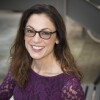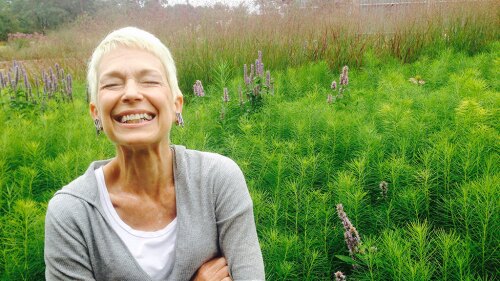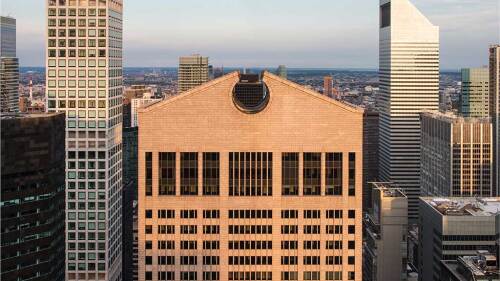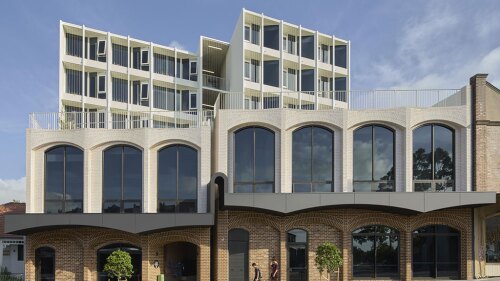
Dr. Robert Bullard—known as the father of environmental justice—has been selected as the 2024 recipient of the ULI Prize for Visionaries in Urban Development. He’s pictured here accepting the Time Earth Award, also this year, for his work on behalf of communities and grassroots organizations.
Dr. Robert Bullard and the Bullard Center for Environmental Justice
Dr. Robert D. Bullard—known as the father of environmental justice and celebrated for his commitment to the idea that all people, regardless of background, have a right to clean air and clean water—has been selected as the 2024 recipient of the Institute’s highest honor, the ULI Prize for Visionaries in Urban Development.
Each year, the ULI Prize recognizes an individual who has made a distinguished contribution to building community globally, who has established visionary standards of excellence in the land use and development field, and whose commitment to creating the highest-quality built environment has led to the betterment of society.
Dr. Bullard serves as Distinguished Professor of Urban Planning and Environmental Policy at Texas Southern University, where he continues to be an advocate for environmental justice and a mentor to the environmental advocates of tomorrow.
He has written numerous books, the first of which, Dumping in Dixie: Race, Class, and Environmental Quality, spotlights the economic, social, and psychological consequences of siting noxious facilities amid African American communities. That book is regarded as the first to fully articulate environmental justice.
Dr. Bullard recently spoke to Urban Land about helping to start the environmental justice movement and how it continues to expand nationally and globally.

In 1979, Northeast Houston residents protest the Whispering Pines Landfill. Dr. Robert Bullard conducted a study for the first lawsuit in the United States that charged environmental discrimination, or environmental racism based on a civil rights law.
Dr. Robert Bullard and the Bullard Center for Environmental Justice
Urban Land: You have worked for 45 years—since the late 1970s—on behalf of communities of color whose members have been victimized by environmental racism, and you are widely known as the “father of environmental justice.” What inspired you to pioneer this field? What makes your brand of sociology different from [that of] the mainstream?
Dr. Robert Bullard: My entry into this field was more accidental, and it was not something that I planned. I’m a sociologist, and I do research . . . . My area [of] specialization was housing and residential segregation, and I worked with census data . . . . One day, my wife, Linda McKeever Bullard, came home—she’s a lawyer—and said, “Bob, I just sued the state of Texas, the city of Houston, and Harris County, [which] were trying to site a sanitary landfill in this predominantly Black middle-class community.” And she said that she had filed a temporary restraining order to try to stop this permit from being approved and [the] facility built, and she needed someone to do a study and put all the solid waste landfills and incinerators in Houston on the map and tell who lives around [them].
And my reply was, “You need a sociologist.”
And she said, “That’s what you are,” and so, that’s how I got drafted [into] doing this study, way back in 1979. The lawsuit was Bean versus Southwest and Waste Management Corporation, [and it] was the first lawsuit in the United States that charged environmental discrimination—environmental racism—and challenged [it] by using civil rights law.
I had 10 students [in my] research methods class at Texas Southern University, where I am now, and I designed this study, and the students and I collected the data, [and] I did the report.
There was no [other] study like that. There was no literature, so I had to start from scratch . . . . What I found is that . . . from the 1930s . . . until 1978, [roughly] 82 percent of all the garbage disposed in Houston was disposed in predominantly Black neighborhoods, even though Blacks made up only [about] 25 percent of the population during that period . . . .
UL: What did you expect to find with your research, if anything?
Bullard: I had no idea.
I had a hypothesis, and a null hypothesis, that says there’s no relationship between where these landfills are located and race—Houston does not have zoning. So, the idea was, in the absence of discrimination, you are likely to have these facilities scattered all across the city, since there’s no zoning. But what we found is that, yes, there is a pattern of where these facilities are located, and that pattern fits neatly with the racial composition of neighborhoods.
The intent, the purpose, was willful, but we couldn’t prove it in court, because we didn’t know anybody back in the ’30s and ’50s and ’60s. And it seems nobody was dumb enough to write it down or get caught on tape, [during] the 1970s, saying that Black neighborhoods in Houston were the best places to dump garbage.
UL: Who had to sign off at the city to site the landfills in Black communities?
Bullard: The city council was all white, up until 1971, so where to put these dumps on line were decisions that were made by [the] city council and mayor. They were all white and, in most cases, white men [who] decided to put these garbage dumps in Black neighborhoods. Judson Robinson Jr. became the first African American to serve on the Houston city council in 1971. Ironically, the first major crisis he faced on the city council involved a city-owned landfill in a northeast Houston Black neighborhood. And then, [once] the laws changed in 1976—when the Environmental Protection Agency came along—and then the regulations for controlling unlined landfills . . . you got the Resource Conservation and Recovery Act [RCRA] that regulated landfills [and] meant that you had to line the landfills, and you had to be regulated, et cetera. So, the old pattern [set in the 1930s] set the precedent and set the tone for the new pattern. Over the decades, white elected officials used Not in My Backyard [NIMBY] practices as a protectionist device to keep solid waste facilities out of their neighborhoods and, at the same time, deployed racist Place in Blacks’ Back Yard [PIBBY] policies and practices to systematically target Black neighborhoods for garbage dumps, landfills, and incinerators.
UL: How did things change after the lawsuit?
Bullard: After the lawsuit, not a single Type 1 [Subtitle D] landfill that’s licensed to receive municipal garbage has been sited in the city of Houston, so it had an impact. But if you look at what’s happening nationally, the same pattern continues in terms of Black and brown communities getting more than their fair share of landfills, incinerators, and other kinds of what we call “locally unwanted land uses,” or LULUs. This pattern holds true, in cities with or without zoning. The same community that we looked at in Houston in our 1979 study—the [place] that had the most landfills . . . garbage dumps, these are the same neighborhoods that that have been denied infrastructure. They’re more likely to flood. [These] neighborhoods are more likely not [to] have parks or green space. They’re urban heat islands and pollution “hot spots.”
These same neighborhoods are more likely to have other [forms of] polluting, so racism and redlining went hand in hand [with] denying Black communities . . . equal protection under the law. And as the Hispanic population grew, over the years, in Houston, we found that that same pattern matched with the [one faced by the] Black community in terms of expansion of these locally unwanted land uses in Black and brown communities.
UL: What was the outcome of the case, and what does discrimination look like today?
Bullard: We lost the case in court, [but] I asked the question, “Is this just Houston? Is this just the South?” That’s how I expanded the study in Houston and started to [work on] Dumping in Dixie, taking a systems approach to look at what’s happening in the South. As I discovered, this [discrimination is not happening just in] Houston.
That discrimination that occurred beginning in the ’30s, in terms of the redlining, extended into the ’70s with the landfills, and . . . now, with the 2020s, with [inadequate infrastructure] flooding, the communities that get hit the hardest, in terms of power outages, winter freezes, and the extent to which they are impacted disproportionately . . . . I have maps to show [those things].
UL: How did you develop this new brand of sociology?
Bullard: I was trying to pattern my work after [that of] a famous . . . Black sociologist, W.E.B. Du Bois. In other words, you do the study, but then the study [doesn’t just] sit on the shelf. The study is supposed to do something else, and . . . I call that “kick-ass sociology,” and one of the most famous “kick-ass sociologists” was Du Bois.
And so, you take the study, and you lift it up. Having the data, having the science, having the facts is not enough to win in a court. That means I’ve got to go gather additional information to show that this [discrimination] is not just an isolated incident, to [be able to] establish a pattern. And that’s where I think this whole idea [exists] of kick-ass sociology and using this framework of marrying data, science, and facts with action and community mobilization to achieve transformative change.
In sociology, we have something called serendipity. The study found five out of five of the city-owned landfills, six of the eight city-owned incinerators, and three of the four privately owned landfills were located in mostly Black Houston neighborhoods. In other words, this discovery [that about] 82 percent [of landfills are located] in Black communities, but Blacks [made up only] 25 percent of the population—that was serendipitous.
UL: What was the reaction to your research?
Bullard: There was a universal state of denial, even in the courts and even with the facts . . . . There were still people who didn’t want to believe environmental racism was real and practiced in Houston. It took years—in some cases, more than a decade—for civil rights and environmental rights to converge. This convergence was our environmental justice movement.
UL: How did you find your way from writing books to helping communities [that are] experiencing environmental racism?
Bullard: I wrote all of my books, over the decades, with the idea of using them to operationalize kick-ass sociology and assist impacted and vulnerable populations and communities [to] make change. In 1994, I left the University of California, Riverside and went back to my alma mater, Atlanta University [now Clark Atlanta University], and started an environmental justice resource center—an education and training, research, policy, civic engagement, and advocacy institute housed at an HBCU [historically black college and university].
It is worth noting [that] the nation’s first environmental justice centers at American [universities] were set up in the 1990s. All five of these centers were set up by Black scholars at HBCUs: Xavier University of Louisiana, Clark Atlanta University, Hampton University of Virginia, and Texas Southern University.
Back then, we had no institutional infrastructure and very little resources. So, we decided we needed centers at our schools, and that’s how we started to build out the institutional infrastructure and community/university partnership model. We developed, tested, and deployed this research model before it had a name. We would [gather] and have our experts come together from the different schools and support struggles on the ground, whether it was Mississippi, Louisiana, Texas, Alabama, Florida . . . mainly in the Jim Crow South, but not exclusively the South, since our HBCU environmental justice [EJ] centers, in the early-1990s [part] of our movement, served as the go-to technical and research support arm for the entire EJ movement.
UL: The centers were initially housed at the HBCUs. Where were predominantly white institutions [PWIs] on the issue in the early 1990s?
Bullard: You must understand that fighting against environmental racism and oppressive systems targeting Black and other people of color [and] fighting for environmental justice in the early 1990s was risky business. There was no groundswell of PWIs rushing in to assist Black and brown communities overburdened with pollution and poverty. You also must remember [that] many of these same PWIs in the South had, not too long ago, vigorously protested and denied Black people admission to their institutions. We were going up against big corporations, in many cases, corporations that endowed a lot of the PWIs and their programs. If [you’re talking] about dealing with oil and gas, fossil fuel, dealing with issues around land permits, et cetera, many of these universities would not touch us or our issues. We had a few professors, a few legal clinics, a few legal clinics at law schools, and a few academic programs at PWIs offering degrees in environmental justice.
I am amazed how much we were able to do during this early period. The field of environmental justice was considered by many as not [being] a legitimate area of study, [of] research, or [of] getting tenure or promoted. When we talk about who led the way, it was HBCUs, not predominantly white institutions—PWIs.
UL: How has that changed today?
Bullard: We have made lots of progress since the late 1970s, when environmental justice was a footnote. Today, it’s a headline. Four decades ago, EJ had limited resources. Today, our movement—community- university partnerships, networks, collaboratives, and consortia—are powerful allies in the march toward environmental justice. Over the stretch of four decades, I’ve witnessed the signing of two presidential executive orders: President Bill Clinton signed Executive Order on Environmental Justice 12898 and, 29 years later, President Joe Biden signed Executive Order 14096 . . . . In 1994, there were no pots of money set aside by Congress for EJ. In 2023, there were substantial resources for EJ, including billions of dollars in the $1.2 trillion Infrastructure Investment and Jobs Act or Bipartisan Infrastructure Law [BIL] and the $369 billion Inflation Reduction Act [IRA], the largest climate funding in the nation’s history. President Biden’s Justice40 initiatives says that 40 percent of the benefits should go to those disadvantaged communities. Again, the IRA has $60 billion dollars spelled out for environmental justice and another $60 billion for clean energy transition. These are historic investments in environmental and climate justice, and in our most disadvantaged and vulnerable communities that, too often in the past, have been left out and left behind.
UL: Today, environmental justice has also become a mainstream course of study in mainstream universities, correct?
Bullard: Yes, almost every major university in this country has some environmental justice program, climate justice program, environmental justice and climate justice, energy justice, health justice—all of that is integrated into the curriculum, and any institution that purports to deal with climate issues that doesn’t have the justice equity lens is inadequate.
Our framework has . . . made it all the way to the top of the federal government, and all the way up to [the] United Nations in terms of climate justice; [it] is basically the fastest-growing aspect of dealing with climate change solutions. [It’s not just this] little community over here, saying, “We want help.” Climate change has internationalized the whole thing.
UL: Your expert testimony won the case [that brought Louisiana Energy Services L.P. before the judges on the Nuclear Regulatory Commission’s Atomic Safety and Licensing Board]. What was the case about, and why was it important?
Bullard: President Clinton signed the executive order on environmental justice in 1994. The first test case to come after that [involved] Citizens Against Nuclear Trash [CANT] versus the Louisiana Energy Service. [In this case, the] company was a collaboration, [a] U.S., British, [Dutch], and German [consortium] that wanted to build the nation’s first privately owned uranium enrichment plant.
Most of uranium, right now, sits at [the Department of Energy], but [the collaborators] wanted to privatize, and the community that they wanted to put it in, northwest Louisiana . . . was sandwiched between two unincorporated Black communities—Forest Grove and Center Springs. The draft environmental impact statement [DEIS], submitted to the NRC [Nuclear Regulatory Commission] for the plant, reported the closest community to the proposed facility was Homer, some five miles away. However . . . Forest Grove Church and Centers Spring Church, located in these two Black communities, date back to 1865 and 1910. White racism erased these two historic Black communities and made them invisible in the DEIS. My [environmental justice] analysis was to make them visible to the [government’s] licensing authority.
And this case was in front of the Nuclear Regulatory Commission Licensing Board, a three-judge panel, in 1989. I was one of the expert witnesses. I did the analysis, showed the process . . . they went through to find the suitable site, and [how,] the closer they got to [finding] the suitable site, the Blacker the community . . . got. And by the time they winnowed down the list to the final site and opened the envelope . . . the winner . . . was Forest Grove and Center Spring, [a pair of] communities . . . where Black people owned land.
The NRC judges ruled, “Permit denied.” Boom. That was a major EJ victory to celebrate.
UL: Where did you grow up, and who was the most influential person in your life?
Bullard: I grew up in Elba, Alabama, a small [town] in southeast Alabama where everything was segregated. My parents were sticklers for education. Education is everything. My grandmother was also a stickler for education. She only had a sixth-grade education but had a PhD in living, financial management, and holding on to her inheritance. Her mother and father were enslaved, but 10 years out of slavery, in 1875, they were able to acquire 240 acres (97 ha) of timberland in southeast Alabama. We don’t know how my great-grandmother and great-grandfather were able to acquire the landholdings. But they did. Our family’s position has always been, “don’t ask, don’t tell.” The land is still in my family. It was drilled into us to never sell the land and [to] keep it in the family. My father and grandmother would sell timber from the land every five or six years and divide the money among my father and his three siblings. The sale of trees from this land provided money to send my three brothers, my sister, and me to college.
My parents and my grandmother were instrumental in shaping my worldview, and what I see as my role and responsibility as a college professor, and as someone who values service. They taught me the importance of giving back. No matter how high you go, always remember someone helped you along the way. And never forget where you came from.
Past Visionary Prize Winners:
Anne Hidalgo
Jeanne Gang
Jonathan F.P. Rose
Suggested Reading
Juneteenth in Louisiana
Homer, Louisiana
45 NRC 367 (1997)









